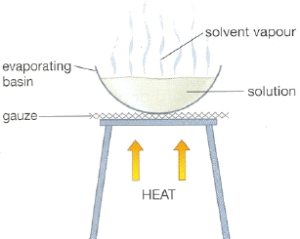Class 9 Exam > Class 9 Questions > What is evaporation Related: NCERT Solutions...
Start Learning for Free
What is evaporation
Verified Answer
What is evaporation Related: NCERT Solutions - Is Matter Around Us Pu...
Evaporation
The process of liquid changing into vapours even below its boiling point is called as evaporation.
Some particles in a liquid always have more kinetic energy than the others.So,even when a liquid is well below its boiling point ,some of its particles have enough energy to break the forces of attraction between the particles and escape from the surface of the liquid in the form of vapours.Thus,the fast moving particles of a liquid are constantly escaping from the liquid to form vapour.

Factors affecting evaporation
1)Temperature
The rate of evaporation increases on increasing temperature of the liquid.When the temperature of a liquid is increased by heating it,more particles of the liquid get enough kinetic energy to go into vapour state.This increases the rate of evaporation.
2)Surface Area
The rate of evaporation increases on increasing the surface area of the liquid.
For Ex:IF the same liquid is kept in a test tube and in a china dish,then the liquid kept in the china dish evaporates more rapidly.
We spread out the washed clothes while drying to increase their surface area for rapid evaporation of water present in them.
3)Humidity of air
The amount of water vapours present in air is called humidity.
When the amount of water vapours present in the air is small it is called dry air.
When the amount of water vapours present in air is large it appears to be damp.
When the humidity of air is low,then the rate of evaporation is high,and water evaporates more readily.
When the humidity of air is high,then the rate of evaporation is low.and water evaporates very slowly.
4)Wind Speed
The rate of evaporation of a liquid increases with the increasing wind speed.
When the speed of wind increases,the particles of water vapours move away with the wind,decreasing the amount of water vapours in the surrounding.This increases the rate of evaporation of water.The washed wet clothes dry more quickly on a windy day because evaporation is faster due to the high speed of the wind.
 This question is part of UPSC exam. View all Class 9 courses
This question is part of UPSC exam. View all Class 9 courses
Most Upvoted Answer
What is evaporation Related: NCERT Solutions - Is Matter Around Us Pu...
Evaporation is the process of changing of water into vapors below its boiling point .It is a surface phenomenon. Hope it will help you!!!!
Community Answer
What is evaporation Related: NCERT Solutions - Is Matter Around Us Pu...
The process of liquid changing into vapour even below its boiling point is called as evaporation.
Attention Class 9 Students!
To make sure you are not studying endlessly, EduRev has designed Class 9 study material, with Structured Courses, Videos, & Test Series. Plus get personalized analysis, doubt solving and improvement plans to achieve a great score in Class 9.

|
Explore Courses for Class 9 exam
|

|
Similar Class 9 Doubts
What is evaporation Related: NCERT Solutions - Is Matter Around Us Pure, Science, Class 9
Question Description
What is evaporation Related: NCERT Solutions - Is Matter Around Us Pure, Science, Class 9 for Class 9 2024 is part of Class 9 preparation. The Question and answers have been prepared according to the Class 9 exam syllabus. Information about What is evaporation Related: NCERT Solutions - Is Matter Around Us Pure, Science, Class 9 covers all topics & solutions for Class 9 2024 Exam. Find important definitions, questions, meanings, examples, exercises and tests below for What is evaporation Related: NCERT Solutions - Is Matter Around Us Pure, Science, Class 9.
What is evaporation Related: NCERT Solutions - Is Matter Around Us Pure, Science, Class 9 for Class 9 2024 is part of Class 9 preparation. The Question and answers have been prepared according to the Class 9 exam syllabus. Information about What is evaporation Related: NCERT Solutions - Is Matter Around Us Pure, Science, Class 9 covers all topics & solutions for Class 9 2024 Exam. Find important definitions, questions, meanings, examples, exercises and tests below for What is evaporation Related: NCERT Solutions - Is Matter Around Us Pure, Science, Class 9.
Solutions for What is evaporation Related: NCERT Solutions - Is Matter Around Us Pure, Science, Class 9 in English & in Hindi are available as part of our courses for Class 9.
Download more important topics, notes, lectures and mock test series for Class 9 Exam by signing up for free.
Here you can find the meaning of What is evaporation Related: NCERT Solutions - Is Matter Around Us Pure, Science, Class 9 defined & explained in the simplest way possible. Besides giving the explanation of
What is evaporation Related: NCERT Solutions - Is Matter Around Us Pure, Science, Class 9, a detailed solution for What is evaporation Related: NCERT Solutions - Is Matter Around Us Pure, Science, Class 9 has been provided alongside types of What is evaporation Related: NCERT Solutions - Is Matter Around Us Pure, Science, Class 9 theory, EduRev gives you an
ample number of questions to practice What is evaporation Related: NCERT Solutions - Is Matter Around Us Pure, Science, Class 9 tests, examples and also practice Class 9 tests.

|
Explore Courses for Class 9 exam
|

|
Suggested Free Tests
Test: The Fundamental Unit of Life- Case Based Type Questions- 1
Test | 10 questions
Signup for Free!
Signup to see your scores go up within 7 days! Learn & Practice with 1000+ FREE Notes, Videos & Tests.

























